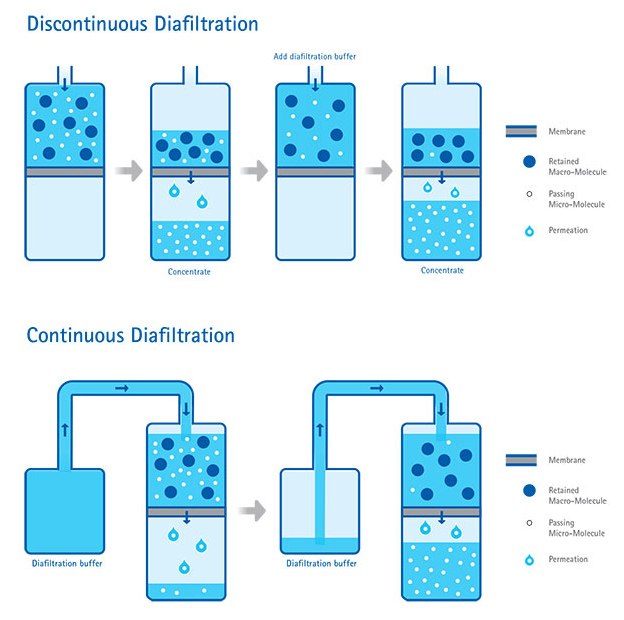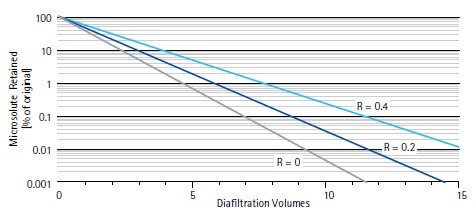Introduction to Concentration and Buffer Exchange Using Amicon® Stirred Cells
- Products
- Simultaneous Sample Concentration and Buffer Exchange by Ultrafiltration Plus Diafiltration
- How to Choose the Correct Ultrafiltration Membrane (NMWCO) for the Sample
- Diafiltration Compared to Dialysis
- Continuous vs. Discontinuous Diafiltration
- Buffer Requirements for Continuous Diafiltration
Sample preparation of macromolecule solutions, such as proteins, enzymes, antibodies, and viruses, often yield large volumes of diluted macrosolutes in buffers that are incompatible with downstream processes or detection.
Centrifugal ultrafiltration devices (such as the Amicon® Ultra Filters) are regularly used to concentrate and buffer-exchange these types of macrosolutes; however, volumes larger than 50 mL present significant challenges, requiring samples to be loaded in multiple stages or aliquoted over several devices.
The Amicon® Stirred Cell family of pressure-driven filtration devices provide an ideal solution for concentrating and buffer-exchanging large volumes of macrosolutes. These devices are available in multiple sizes to offer a wide range of processing volumes. To process even larger volumes, an external reservoir can be attached to any Amicon® Stirred Cell.
The new generation of Amicon® Stirred Cells provides ergonomic benefits, integrated safety features, a more secure stir bar, superior integrity, and ease of use while also providing a broader selection of membrane discs.
Products
See how the improved design of Amicon® Stirred Cells enables more secure assembly, better device integrity, and the same unmatched performance.
Simultaneous Sample Concentration and Buffer Exchange by Ultrafiltration Plus Diafiltration
Ultrafiltration is a proven method for sample concentration. When combined with diafiltration, the analyte of interest is provided at a concentration and in a buffer that is compatible with additional purification and analysis steps. During ultrafiltration, the desired macrosolute concentration is achieved because the concentration of non-permeating species is increased while the fluid volume is reduced. Furthermore, the concentration of membrane-permeating species such as salts and microsolutes remains unchanged.
How to Choose the Correct Ultrafiltration Membrane (NMWCO) for the Sample
When using ultrafiltration for sample concentration, particular attention has to be paid in choosing the correct membrane molecular weight cut-off, as well as membrane material. Ultrafiltration membranes are typically made from regenerated cellulose or polyethersulfone (PES). The material of choice will greatly depend on sample compatibility. The choice of membrane nominal molecular weight cut-off (NMWCO) will depend on the molecular weight (MW) of the macrosolute that is to be retained. Membrane choice will have a significant impact on performance. As a rule, the NMWCO should be 2-3 times smaller than the molecular weight of the solute to be retained when using regenerated cellulose and 4-5 times smaller for Biomax® PES membranes.
Solute retention may be further influenced by:
- Processing temperature
- Operating pressure
- Stir speed
- Sample concentration
- Sample constitution
You may need to optimize the above parameters to assure desired yield. The most frequently used ultrafiltration membranes have a NMWCO range of 3 kDa to 100 kDa, although smaller and larger pore sizes are available.
Diafiltration Compared to Dialysis
Diafiltration is a technique that uses ultrafiltration for buffer exchange. Diafiltration can rapidly and efficiently eliminate salts and/or microsolutes from macromolecular mixtures. This process is typically called “washing out.”
The term “washing in” is used when diafiltration is employed to replace one salt species or microsolute with another, as is done during buffer exchange.
Traditional dialysis is an alternative buffer exchange technique; however, it has several drawbacks:
- It relies on slow diffusion and difficult-to-handle dialysis tubing or cassettes.
- In many cases, during the course of dialysis, the volume in the dialysis tubing increases as a consequence of osmosis, further diluting the sample and requiring a sample concentration step.
- Dialysis can require large buffer volumes and multiple buffer changes.
In contrast, diafiltration uses ultrafiltration membranes, either in centrifugal or pressure-driven devices such as the Amicon® Stirred Cell, for efficient buffer exchange.
Advantages of diafiltration using stirred cell ultrafiltration:
- Unlike dialysis tubing, ultrafiltration membranes can be used for both sample concentration as well as buffer exchange
- Minimizes sample transfers and reduces sample loss.
- Diafiltration often requires significantly less buffer volume than traditional dialysis.
Continuous vs. Discontinuous Diafiltration
Diafiltration can be performed in either continuous or discontinuous mode. Discontinuous diafiltration refers to a practice where the sample is first concentrated, then diluted with exchange buffer to the initial starting volume, followed by another concentration step. This process is repeated until the desired microsolute has been exchanged.
On the other hand, continuous diafiltration maintains a constant volume throughout the buffer exchange process, by introducing exchange buffer at the same rate as filtrate is being removed. By maintaining a fixed volume, the retained solute concentration remains constant, providing a gentler method of buffer exchange.
In general, continuous diafiltration is more efficient than discontinuous diafiltration. In discontinuous diafiltration, the permeate flux decreases as the sample concentration increases, which can contribute to membrane fouling and cause increased retention of microsolutes that would otherwise pass through the membrane.

Comparison between discontinuous and continuous diafiltration for a solution containing a retained macrosolute and a passing microsolute.
Calculating Buffer Exchange Volume for Continuous Diafiltration
The buffer requirement during diafiltration is typically expressed as “diafiltration volume” (DV). The DV is equal to the volume of the permeate removed during diafiltration divided by the volume of the remaining retentate (Equation 1).
Microsolutes that are partially retained by the membrane will require additional DV. As a general rule of thumb, using DV=three times the sample volume will wash out 95%, and using DV=five times the sample volume will remove 99% of a non-retained microsolute.
Equation 2 can be used for theoretical calculations of diafiltration volume requirements. However, these are guidelines and actual diafiltration volume requirements need to be empirically determined.

A more precise characterization for both wash-in and wash-out continuous diafiltration. The figure demonstrates theoretical diafiltration volumes for microsolutes that pass through the membrane (R=0), as well as partially retained microsolutes (R=0.1, 0.2 etc.).
Calculating Buffer Exchange Volume for Discontinuous Diafiltration
In discontinuous diafiltration, salt and microsolute removal depend on the degree of concentration during the repeated concentration/dilution steps. The microsolute level decreases according to Equation 3 during each step.
Example: A 100 mL of a 1 mg/mL bovine serum albumin (BSA) protein sample containing 1 M salt is concentrated down to 50 mL, concentrating the protein to 2 mg/mL while the salt concentration is constant at 1 M. Then, the sample is diluted back to 100 mL, reducing BSA concentration to 1 mg/mL and the salt concentration down to 0.5 M. Each diafiltration step reduces the salt concentration by 50%.
These two steps are repeated until the salt has been reduced to the desired concentration.
The salt concentration after each step can be calculated using Equations 3 and 4:
The above should be viewed as a guideline, as sample types and composition vary greatly and overconcentration could have detrimental consequences.
While continuous diafiltration is traditionally used with large volume tangential flow filtration (TFF) systems, you can use this gentle form of buffer exchange with the Amicon® Stirred Cell.
The same reservoir used to extend the processing volume during sample concentration can now be used for the diafiltration buffer. Once pressure has been applied and equalized throughout the setup, exchange buffer will enter the stirred cell at the same rate at which the permeate is being removed.
To continue reading please sign in or create an account.
Don't Have An Account?